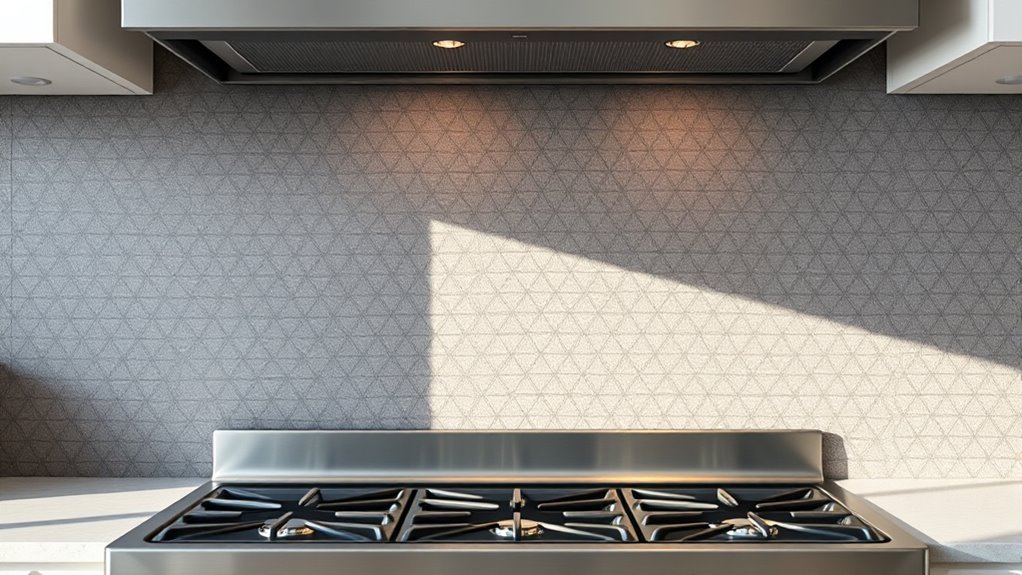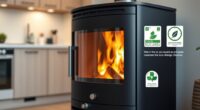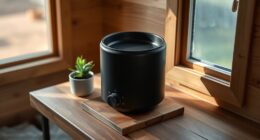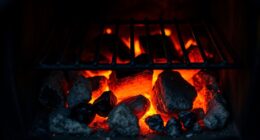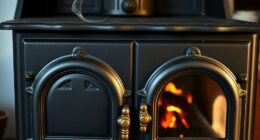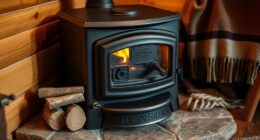To construct a fire-resistant wall panel behind your stove, start by measuring your space and clearing debris, grease, and old paint to create a smooth surface. Choose a suitable fire-resistant material like mineral boards or fire-rated gypsum, ensuring it’s rated for stove use and complies with local codes. Follow manufacturer instructions carefully for installation, securely fastening the panel and sealing joints to prevent heat transfer. Keep reading to learn more about safe, effective installation techniques.
Key Takeaways
- Measure the space accurately and select fire-resistant panels rated for stove installation.
- Prepare the wall surface by cleaning and creating a smooth, debris-free area for mounting.
- Follow manufacturer instructions carefully to securely fasten the panel, maintaining proper clearances from the heat source.
- Seal joints and edges with heat-resistant sealant to prevent heat transfer and grime buildup.
- Verify the panel’s fire resistance rating and ensure compliance with local safety codes before installation.
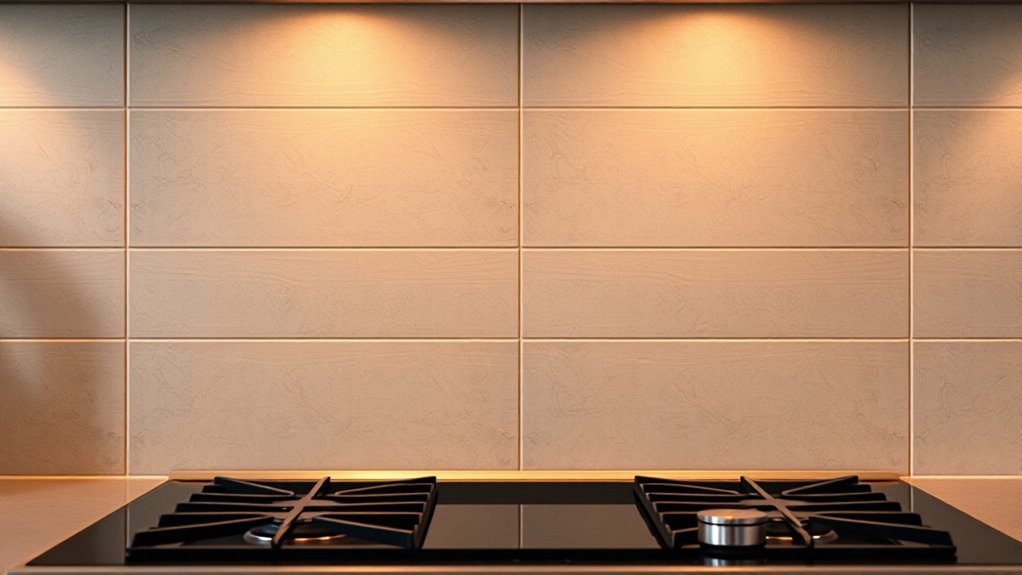
Installing a fire-resistant wall panel behind your stove is a smart way to enhance safety in your kitchen. When you’re considering this upgrade, it’s essential to follow proper installation guidelines to ensure the panel functions effectively and adheres to safety standards. First, you need to carefully assess the area where the panel will be installed. Measure the space accurately to determine the size of the panel needed, making sure it covers all vulnerable areas behind the stove. Clear the wall surface of any debris, grease, or old paint to create a clean, smooth surface for installation. Then, choose a suitable mounting method, whether it’s using screws, brackets, or adhesive, depending on the material and your wall type. Always follow the manufacturer’s instructions for installation, paying close attention to recommended clearances from heat sources, and ensure the panel is securely fastened to prevent any movement or gaps that could compromise safety.
Material selection is a critical step in this process. You want to pick a fire-resistant material that can withstand high temperatures and resist ignition. Common options include mineral-based boards, fire-rated gypsum, or specialized heat-resistant panels. When selecting the material, consider factors such as durability, ease of installation, and compatibility with your kitchen’s aesthetics. For example, mineral boards are highly fire-resistant and moisture-proof, making them ideal for kitchen environments. Fire-rated gypsum panels are easier to cut and install but may require additional protective finishing. Whatever material you choose, ensure it’s rated for use behind stoves and complies with local building codes. Also, consider whether the panel needs to be painted or finished with a heat-resistant coating to match your decor, and select a product that can be easily maintained.
Additionally, you should verify the panel’s fire resistance rating to ensure it meets safety standards for kitchen environments. It is also helpful to review the installation guidelines provided by the manufacturer to avoid common mistakes during setup. Once you’ve selected your material, double-check that it meets safety standards and is suitable for kitchen use. During installation, pay attention to the placement of electrical outlets and fixtures to avoid interference or potential hazards. Seal all joints and edges properly to prevent heat transfer or the buildup of grease and grime. After installation, inspect your work thoroughly to ensure there are no gaps or loose fittings. Properly installed, a fire-resistant wall panel provides a reliable barrier that minimizes fire risk, giving you peace of mind while cooking. Remember, adhering to the right installation guidelines and choosing the appropriate material are crucial steps toward creating a safer kitchen environment for you and your loved ones.
Frequently Asked Questions
What Are the Fire Ratings Required for These Panels?
You need to guarantee the panel has a fire rating of at least one hour to meet fire rating requirements and enhance panel fire safety. Local building codes typically specify these standards, so check your area’s regulations. Use fire-resistant materials like mineral fiber or cement board. Proper installation and maintenance are vital to keep the panel effective. Always verify with local authorities for specific fire safety standards applicable to your situation.
Can Fire-Resistant Panels Be Painted or Customized?
Fire-resistant panels can be painted or customized, but you should use fire-resistant coatings specifically designed for such surfaces. These coatings maintain the panel’s fire-resistance properties while allowing for aesthetic adjustments. When considering panel customization, select fire-resistant paints or finishes that won’t compromise safety. Always verify that any modifications meet local fire safety standards to ensure your wall remains protected and compliant.
How Do I Maintain the Panel’s Fire Resistance Over Time?
To maintain your fire-resistant panel’s effectiveness, regularly clean it with a damp cloth to remove dust and debris, avoiding harsh chemicals. If you want decorative finishes, choose heat-safe paints or coatings that won’t compromise the panel’s fire resistance. Avoid abrasive cleaning tools, and inspect the panel periodically for damage or wear. Proper maintenance guarantees your panel stays fire-resistant and looks great over time.
Are There Specific Building Codes for Kitchen Wall Panels?
Think of building codes as your recipe for safety; they specify ventilation requirements and panel material options. You must adhere to local regulations for kitchen wall panels, which ensure fire safety and proper ventilation. These codes often mandate fire-resistant materials and proper clearance around stoves. Staying compliant keeps your kitchen safe and avoids legal trouble, so always check with your local building department before installation.
What Is the Installation Process for a Fire-Resistant Panel?
You start by gathering all necessary materials and tools for installation steps. First, measure and cut the fire-resistant panel to fit the designated space. Next, secure the panel to the wall using appropriate fasteners, making certain it’s flush and stable. Throughout, follow safety precautions like wearing gloves and goggles, and verify power is off if working near electrical outlets. Double-check the installation for stability and compliance with local codes before use.
Conclusion
By choosing to install a fire-resistant wall panel behind your stove, you’re gently safeguarding your home without making a fuss. It’s like adding a quiet guardian that quietly steps in when needed, offering peace of mind and a touch of reassurance. With this subtle upgrade, you create a cozy space where warmth and safety coexist harmoniously. Sometimes, the most unassuming choices make the biggest difference—giving you comfort that’s both subtle and steadfast.

